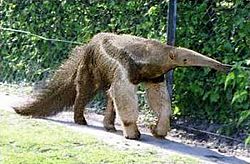Pilosa facts for kids
Quick facts for kids Pilosa |
|
|---|---|
 |
|
| Giant Anteater Myrmecophaga tridactyla | |
| Scientific classification | |
| Kingdom: | |
| Phylum: | |
| Class: | |
| Superorder: | |
| Order: |
Pilosa
|
| Suborder | |
|
Vermilingua - anteaters |
|
Pilosa is a group of mammals. These animals belong to a larger group called Xenarthra. The word "Pilosa" means "hairy" in Latin.
This group includes two main types of animals: the sloths and the anteaters. Sloths are known for being very slow. Anteaters are famous for eating ants and termites. Both groups live in Central and South America.
Contents
What are Pilosa?
Pilosa is a scientific order of animals. An order is a way scientists group living things. Animals in the Pilosa order share special features. These features include unique backbones and strong claws.
The Pilosa order was named by William Henry Flower in 1883. He was a famous British zoologist.
Sloths: The Slow Movers
Sloths are part of the Pilosa group. They are known for moving very slowly. This helps them save energy. They spend most of their lives in trees.
Sloths eat leaves, twigs, and buds. Their slow digestion helps them get nutrients from these foods. There are two main kinds of sloths: two-toed and three-toed sloths.
Where Sloths Live
Sloths live in the rainforests of Central and South America. They use their long claws to hang upside down from branches. Their fur often has algae growing on it. This helps them blend in with the trees.
Anteaters: Insect Eaters
Anteaters are the other main group in Pilosa. They are famous for their long snouts and sticky tongues. They use these to catch insects. Their favorite foods are ants and termites.
There are four types of anteaters. These include the giant anteater and the silky anteater. Each type has adapted to its environment.
Where Anteaters Live
Anteaters live in different habitats. These include grasslands, forests, and swamps. They are found in Central and South America. Some anteaters, like the giant anteater, live on the ground. Others, like the silky anteater, live in trees.
Unique Features of Pilosa
Animals in the Pilosa order have special bones. Their backbones have extra joints. This makes their spines very flexible. This feature is called "xenarthry." It is how the superorder Xenarthra got its name.
Pilosa animals also have strong claws. Sloths use their claws to hang from trees. Anteaters use theirs to dig into ant nests. These claws are very important for their survival.
Ancient Pilosa
Long ago, there were many more types of Pilosa. Some were much larger than today's animals. These included giant ground sloths. They were as big as elephants!
One famous giant ground sloth was Nothrotheriops. These huge animals lived on the ground. They ate plants, just like modern sloths. They are now extinct. Scientists learn about them from their fossils.
Images for kids
-
Restoration of the ground sloth Nothrotheriops
See also
 In Spanish: Pilosos para niños
In Spanish: Pilosos para niños


